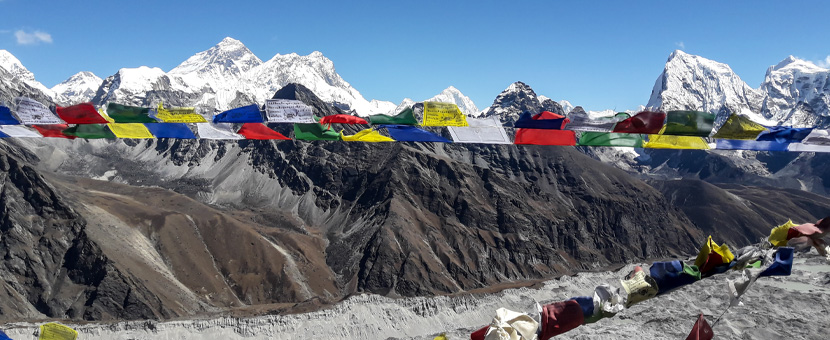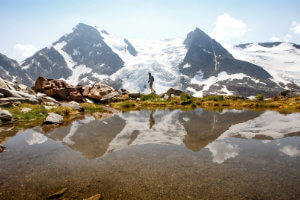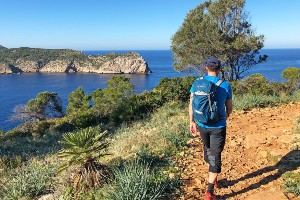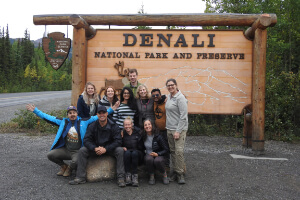Subscribe to newsletter
Find out about flash sales, new trips, what's new and gear giveaways.
Prices
From USD$2,250
-
17 days / 16 night
See available dates
-
Difficulty
- Guided
- Lodges
-
- No Booking or Credit Card Fees
-
- Save Money
-
- Happiness Guaranteed
Is this tour for me?
The Everest Base Camp and Gokyo Lakes Trekking Tour is a very difficult tour, with a long duration at high altitude. We rate this tour as a 5 / 5. Sections of the trail are strenuous, but at higher elevations, even easier sections of trail become more challenging. Consult your doctor if you have concerns about trekking at high altitudes.
Get In Touch
SALE!
Let me know when you have flash sales.
Highlights
Explore Nepal's majestic Himalayas on this epic 17-day guided trek
Experience majestic Mount Everest from up close, at Everest Base Camp, then climb to the peak of Kala Patthar at sunrise, for an epic view of Mount Everest.
Explore the six glacial lakes of the Gokyo region, their stunning turquoise colour appearing even more vibrant against the black and white of the snow-capped peaks.
Learn more about the native Sherpa culture and religion by visiting villages, interacting with people, and exploring monasteries, and witnessing chortens, prayer flags, and more.
Visit Kathmandu, the capital city of Nepal, including some of Kathmandu’s most important landmarks.
For avid trekkers, there is perhaps no location on earth quite as alluring as the Mount Everest Base Camp and the spectacular trail that leads there. This amazing 3-week tour takes you to this epic location, while also showing you that the Himalayas are so much more than Everest.
Surround yourself with some of the tallest and most incredible mountains in the world. Experience Mount Everest not only from its base camp but perhaps even more strikingly, from the peak of Kala Patthar at sunrise. In addition to the traditional Everest Base Camp route, this tour also adds a chance to see the six glacial lakes of Gokyo. The natural beauty of this region is difficult to capture in words – it simply must be experienced.
In addition to these breathtaking landscapes, you’ll have opportunities to experience the culture of the native Sherpa people. Visit monasteries and see their chortens, prayer flags, and other expressions of religious devotion. Stay in local tea houses along your trek, with opportunities to interact with local people and learn more about their way of life. This Everest Base Camp and Gokyo Lake Trek is an unforgettable and life-changing experience, so don’t miss this opportunity!
For avid trekkers, there is perhaps no location on earth quite as alluring as the Mount Everest Base Camp and the spectacular trail that leads there. This amazing 3-week tour takes you to this epic location, while also showing you that the Himalayas are so much more than Everest.
Surround yourself with some of the tallest and most incredible mountains in the world. Experience Mount Everest not only from its base camp but perhaps even more strikingly, from the peak of Kala Patthar at sunrise. In addition to the traditional Everest Base Camp route, this tour also adds a chance to see the six glacial lakes of Gokyo. The natural beauty of this region is difficult to capture in words – it simply must be experienced.
In addition to these breathtaking landscapes, you’ll have opportunities to experience the culture of the native Sherpa people. Visit monasteries and see their chortens, prayer flags, and other expressions of religious devotion. Stay in local tea houses along your trek, with opportunities to interact with local people and learn more about their way of life. This Everest Base Camp and Gokyo Lake Trek is an unforgettable and life-changing experience, so don’t miss this opportunity!
Read more

Everest Base Camp and Gokyo Lake Trek Itinerary
Day 1 Fly to Lukla, then Trek to Phakding
Start your trip by being picked up from your hotel in Kathmandu. View the incredible Himalayas from above today as you fly from Kathmandu to Lukla (2,845 m/9,334’). When you arrive, meet your trekking crew and take a short break for tea. Then your trek begins! Today’s trek is a short and easy warmup, but it may feel more difficult as you adjust to the high elevation. Begin your trek northward to the Dudh Koshi Valley and descend from the plateau into the forests of the valley. After a break for lunch, continue north, crossing several streams, to reach Phakding (2,650 m/8,694’). Spend the night in the Phakding settlement, surrounded by inspirational views.
Overnight Location: Lodge in Phakding (2,845 m/9,334’)
Distance: 12 km, 5 hours, 100 m of ascent
Meals: Lunch, Dinner
Day 2 Trek to Namche Bazaar
Today’s hike crosses over farmland and through settlements on your way to Namche Bazaar (3,440 m / 11,286’). The trail follows the Dudh Kosi River northward, through incredible forests of magnolia, fir and rhododendron trees. After crossing the Bhote Kosi, the western fork of the river, you’ll climb steeply up toward Namche Bazaar. Often called the Gateway to Mount Everest, the Sherpa village of Namche Bazaar is large and prosperous because it is an important center for trade. A bazaar, or market, is held here weekly, gathering sellers from many local villages to sell fresh food.
Overnight Location: Lodge in Namche Bazaar (3,440 m/11,286’)
Distance: 16 km, 7 hours, 700 m of ascent, 200 m of descent
Meals: Breakfast, Lunch, Dinner
Day 3 Acclimatization in Namche Bazaar
Today is a rest and acclimatization day in Namche Bazaar, allowing time for your body to adjust to the altitude. Staying active even on rest days like this will help you as you continue trekking. Take a short hike to the nearby villages of Thamo or Synboche to help you be both physically and mentally fit to continue your journey.
Overnight Location: Lodge in Namche Bazaar (3,440 m/11,289’)
Distance: 6 km, 3 hours, 300 m of ascent, 300 m of descent
Meals: Breakfast, Lunch, Dinner
Day 4 Trek to Dole
Follow the main trail that leads to Thyangboche. The trail then branches off and flanks the sacred mountain peak, Khumblia (5,761 m/18,900’). Walk through some lovely yak pastures then ascend gradually up to Mon La. Below you’ll see the confluence point of the Dudh Koshi and the Imja Khola rivers. Pass the Thyangboche Monastery in a beautiful location with Kantega and Ama Dablam in the background. At the top of the ridge (3,992 m/13,097’), there is a stupa decorated with traditional prayer flags. Descend again through the forest to the river, then follow the trail up to the ridge to the village of Phortse Thanga (3,600 m/11,811’). Continue hiking along the river from Phortse Thanga to the village of Dole (4,038 m/13,248’) where you’ll spend the night.
Overnight Location: Lodge in Dole (4,038 m/13,248’)
Distance: 11 km, 7-8 hours, 600 m of ascent, 400 m of descent
Meals: Breakfast, Lunch, Dinner
Day 5 Trek to Machhermo
Today’s hike is a steady climb up to your overnight stop in Machhermo (4,410 m/14,469’) with just a short lunch break. Enjoy a leisurely afternoon in Machhermo with opportunities to visit the village and learn about the local culture and lifestyle through interactions with local people. If you aren’t too tired, you can walk up to a ridge to enjoy a lovely view of the surrounding Gokyo Valley.
Overnight Location: Lodge in Machhermo (4,410 m/14,469’)
Distance: 8 km, 5 hours, 800 m of ascent, 200 m of descent
Meals: Breakfast, Lunch, Dinner
Day 6 Trek to Gokyo
Climb up past a chorten on a ridge today and enjoy a clear view of the valley as well as majestic mountains including Kangtega, Thamserku, and Cho Oyu. A gentle walk brings you to Phanga, then you will descend to the bank of the river. From there, climb up again to the terminal moraine of the Ngozamba Glacier. As you follow the trail through the valley, you will pass the first three Gokyo lakes: Longpongo, Taboche Tso, and Dudh Koshi. The Taboche Tso and Dudh Koshi lakes are linked together by a flowing stream. The village of Gokyo (4,750 m/15,584’) is beside the Dudh Koshi, and in this beautiful location you’ll stop for dinner and spend the night.
Overnight Location: Lodge in Gokyo (4,750 m/15,584’)
Distance: 9 km, 6 hours, 300 m of ascent, 100 m of descent
Meals: Breakfast, Lunch, Dinner
Day 7 Trek to Gokyo Ri
Hit the trail early today to allow plenty of time to climb to the peak of Gokyo Ri (5,480 m/17,979’). This summit gives you breathtaking views of the Himalaya mountain, especially the regal peaks of Everest, Makalu, Lhotse, Cho Oyu, and Nuptse. You can also hike to another lookout called Scoundrel’s Viewpoint, and explore the fourth and fifth Gokyo lakes, perhaps even the sixth depending on time. Return to Gokyo village for dinner and another night in the lodge.
Overnight Location: Lodge in Gokyo (4,750 m/15,584’)
Distance: 8 km, 6-7 hours, 800 m of ascent, 800 m of descent
Meals: Breakfast, Lunch, Dinner
Day 8 Trek to Dragnag
Leaving Gokyo, your path today traverses a glacier, full of ups and downs. It is not a long walk and you’ll soon descend through the valley to come to Thangana, the Cho La Pass base camp. Spend the day surrounded by natural beauty and magnificent mountain views. Before long, the trail takes you to Dragnag (4,700 m/15,420’), which is your stop for the night.
Overnight Location: Lodge in Dragnag (4,700 m/15,420’)
Distance: 3 km, 4 hours, 300 m of ascent, 200 m of descent
Meals: Breakfast, Lunch, Dinner
Day 9 Trek over Cho La Pass to Dzongla
The trekking today is difficult and requires caution. The trail is very steep, vertical at times, and the rocks can be icy and slippery. As you climb the rocky trail through the narrow valley, you’ll walk beside a frozen lake with majestic and well-known mountain peaks in view. To the south, you’ll see Ama Dablam, which is shaped like a pyramid. To the west is Cholatse and to the east, Lobuche with Baruntse rising sharply on your right. Cross the Cho La Pass (5,420 m/17,782’), then descend to Dzongla (4,840 m/15,879’), where you’ll have dinner and spend the night with clear views of these amazing mountains.
Overnight Location: Lodge in Dzongla (4,840 m/15,879’)
Distance: 15 km, 8-9 hours, 720 m of ascent, 500 m of descent
Meals: Breakfast, Lunch, Dinner
Day 10 Trek to Lobuche
Walk today from Dzongla to Lobuche, which is near the Khumbu Glacier. Your guide will lead you to two peaks today, Lobuche East and Lobuche in the Far East. Throughout the day, enjoy incredible views of Lobuche, as well as Everest, Ama Dablam, Pumori, and the Nuptse-Lhotse. There will be time to explore the village of Lobuche (4,910 m/16,109’) before stopping to watch a truly unforgettable sunset view.
Overnight Location: Lodge in Lobuche (4,910 m/16,109’)
Distance: 8 km, 5-6 hours, 70 m of ascent
Meals: Breakfast, Lunch, Dinner
Day 11 Trek to Gorak Shep & Everest Base Camp
Today is the day you will visit the Everest Base Camp! Make your way along the western side of the Khumbu Valley, then the trail ascends gently through the meadows that are near the glacial moraine. Stop to appreciate the views around you of Lingtren, Pumori, Nuptse, Khumbutse, and Lobuche East, as well as the Khumbu Icefall. Descend slightly to come to Gorak Shep, where you can have lunch and prepare to trek to Everest Base Camp (5,545 m/18,192’). Make this journey in the afternoon, surrounded by mighty peaks and frozen lakes, then return again to Gorak Shep to spend the night.
Overnight Location: Lodge in Gorak Shep (5,140 m/16,864’)
Distance: 10 km, 8-9 hours, 600 m of ascent, 150 m of descent
Meals: Breakfast, Lunch, Dinner
Day 12 Trek to Kala Patthar, then to Lobuche
Get a very early start today for the great reward of reaching the summit of Kala Patthar (5,550 m/18,209’), one of the best viewpoints in the Himalayas, in time to watch the sunrise. The climb to Kala Patthar is steep and it seems the bends in the trail may never end, but once you’re there it will all be worth it. This is the perfect place to view Mount Everest, and it may seem as though you can reach out and touch Mount Pumori. Have your camera ready for capturing incredible photographs today. Descend again to Lobuche after this spectacular, once-in-a-lifetime day on the trail.
Overnight Location: Lodge in Lobuche (4,910 m/16,109’)
Distance: 8 km, 6 hours, 635 m of ascent, 600 m of descent
Meals: Breakfast, Lunch, Dinner
Day 13 Trek to Dingboche
After breakfast, begin your day with a descent through Dusa that brings you to the chorten that marks the head of the Imja Khola River. Then continue with a relatively easy climb, following the wide trail to Pangboche village. You’ll have the opportunity to visit the region’s oldest monastery, the Pangboche Gompa, before continuing your hike to Dingboche. Stop in Dingboche (4,430 m/14,534’) for dinner and to spend the night.
Overnight Location: Lodge in Dingboche (4,430 m/14,534’)
Distance: 6 km, 4 hours, 500 m of descent
Meals: Breakfast, Lunch, Dinner
Day 14 Trek to Tengboche
Follow the trail as it descends into the valley, crossing the Khumbu Khola bridge then climbing again. At the stone huts that are near Orso, the trails join with the upward trail for a time, then diverges again. The trail to the right continues higher and leads through Upper Pangboche to the village of Phortse. You will follow the lower trail to the left which leads to Tengboche. Cross the river from high above on an exciting suspension bridge as the water rushes through a narrow point, and you’ll come to Debache. From here, a short but beautiful trail climbs up through a woodland of rhododendron, birch and conifer trees. When you reach Tengboche (3,860 m/12,664’) you will stop for the night. While you’re in Tengboche, don’t miss the chance to visit the monastery, which in addition to being very beautiful is also the religious monument for the Sherpa people of this region.
Overnight Location: Lodge in Tengboche (3,860 m/12,664’)
Distance: 6 km, 6 hours, 150 m of ascent, 570 m of descent
Meals: Breakfast, Lunch, Dinner
Day 15 Trek to Monjo
The trail today will follow the Dudh Koshi River again, passing lovely waterfalls as it meanders through a forest of rhododendrons, then a pine forest where you may be able to watch musk deer grazing. Continue descending to reach Larja Dobhan, where you should be sure to pause to take in one final view of Mount Everest and Lhotse. After you pass the village of Jorsale, the trail begins to ascend slightly. Cross the suspension bridge to reach Monjo (2,835 m/9,301’), where you will spend the night.
Overnight Location: Lodge in Monjo (2,835 m/9,301’)
Distance: 12 km, 6-7 hours, 400 m of ascent, 1000 m of descent
Meals: Breakfast, Lunch, Dinner
Day 16 Trek to Lukla
Complete your trek today with a steep hike back down to the Dudh Kosi River, before a long but gentle walk brings you back to Lukla. You’ll celebrate your completed journey at the local tea house with clear views of the rugged mountains you’ve been exploring. It’s now time to say farewell to the crew that you have been trekking with for all this time. Spend the night in Lukla (2,840 m/9,318’) and prepare to return to Kathmandu tomorrow.
Overnight Location: Lodge in Lukla (2,840 m/9,318’)
Distance: 10 km, 6-7 hours, 50 m of ascent, 100 m of descent
Meals: Breakfast, Lunch, Dinner
Day 17 Fly to Kathmandu
Enjoy the spectacular return flight from Lukla to Kathmandu, which is perhaps even more incredible now that the mountains have become so familiar. After landing in Kathmandu, the remainder of the day is free for exploring the city, shopping, sightseeing, or simply finding a great cafe or roof-top restaurant. Reward yourself with some fun and rest to celebrate completing this amazing journey.
Overnight Location: None
Distance: None
Meals: Breakfast
2018
2019
Everest Base Camp Trek and Gokyo Lakes Price and Dates
This guided trekking tour in Nepal is run either as a private tour for your group only, however, sometimes there are options to join other groups (please enquire for more information).Pricing below is per person:
- Guided group of 2+: USD2250 per person
Accommodation on Everest Base Camp and Gokyo Lake Trekking Tour
This tour is based in trekking lodges, also called tea houses, along the trek. These accommodations are simple, since there is no road access to reach them, but they are also friendly and full of atmosphere.
Most lodges have dining areas that are heated, but the bedrooms are typically unheated. Wooden beds with foam mattresses are provided, but you will need a sleeping bag. Washing and toilet facilities are shared, and some have solar showers available for an additional charge.
In some cases, accommodation listed below may need to be substituted for other, comparable accommodations.
Single Rooms and Solo Travelers
Private rooms are not available in the trekking lodges.
What’s included in the Everest Base Camp and Gokyo Lake Trekking Tour?
Meals
16 breakfasts, 17 lunches, 16 dinners are included on this tour.
Accommodations
Accommodations for all 16 nights are included. Along the trek, stay in simple trekking lodges (tea houses). You can book accommodation in Kathmandu during the booking process. It is highly recommended to book additional nights in Kathmandu before the trek to get used to the high altitude.
Transportation during the Tour
Domestic flights and land transportation described in the itinerary are included, as well as all airport taxes.
Also Included
- An experienced, insured, and equipped English-speaking guide
- TIMS permit
- National Park permit
- Porter (Insured and equipped according to IPPG rules)
- Acclimatization days exploring Namche and Dingboche
- Ascents of Kala Patthar (5,545 m) and Gokyo Ri (5,480)
- Visit to the village of Phortse, a traditional Sherpa village in the Khumbu region
Not included
- Flights to/from Kathmandu
- Visa to enter Nepal
- Meals not listed as included (lunches and dinners in Kathmandu)
- Personal drinks / alcohol
- Additional costs due to illness, rescue, force majeure, flight/itinerary changes
- Tips for guides and other trekking staff
- Personal costs such as charging batteries or hot showers
Optional extras
- Kathmandu package: airport pickup and drop off, 4 additional nights in Kathmandu in 3-4-star hotel, welcome dinner, Kathmandu City Tour: USD260 per person
- How hard is Everest Base Camp and Gokyo Lakes Trekking Tour?
- Should I be concerned about altitude trekking to Everest Base Camp and Gokyo Lakes?
- Do I need a Visa?
- Are meals included?
- Do I need insurance?
- How do I get to Kathmandu to start this tour?
- Are the tours in English?
- Where does the tour end?
- What should I pack?
- Can I charge my phone / camera / other device?
- How much spending money will I need?
- How much should I tip my guide and porter
- Do I need vaccines?
- Are there any travel restrictions for this country?
- When is the best time to travel to Nepal for this tour?
The Everest Base Camp and Gokyo Lakes Trekking Tour is a very difficult tour, with a long duration at high altitude. We rate this tour as a 5 / 5. Sections of the trail are strenuous, but at higher elevations, even easier sections of trail become more challenging. Consult your doctor if you have concerns about trekking at high altitudes.
You should always check with your doctor before taking a trekking tour at elevation. On this trekking trip to Everest Base Camp and Gokyo Lakes you spend an extended time at high altitude. On Day 4 you reach Namche Bazaar (3,440 m/11,286’), and you’ll be above this elevation until Day 17. You’ll be sleeping above 4,000m from Night 6 in Dole to Night 15 in Dingboche. The highest elevation you’ll sleep at is Night 10 at Gorak Shep, where you’ll sleep at (5,140 m/16,864’). The highest elevation you’ll hike to is Everest Base Camp, at 5,545 m/18,192’. While this trekking tour follows a standard route, it’s a challenging tour and acclimatization is critical.
Check with your local country about visa requirements. You could also try this website, though you should verify with your government.
16 breakfasts, 17 lunches, 16 dinners are included on this tour.
Yes, it is mandatory to have Health and Medical insurance to join this trip. Get your Travel Insurance.
The Tribhuvan International Airport in Kathmandu is the only international airport in Nepal. If arriving in Nepal by air, you must fly to this airport.
Yes, the tour guide is English speaking.
The tour ends where it begins, in Kathmandu.
You will be given a complete packing list for your trek upon booking. Plan to layer your clothing to be comfortable at different temperatures. You should be able to add a waterproof layer (jacket and trousers) to stay dry, as well as protect yourself from the sun with a hat and sunglasses. A headlamp with extra batteries is also recommended. You will carry your own daypack (30 L recommended) during the day and your baggage on the trek is limited to 12 kg. You should also have a sleeping bag (rated for -10°C), dry bags, a padlock (to lock your trek bag) and a basic first aid kid. Please respect the traditional Nepalese culture by dressing conservatively (avoid bare shoulders and keep legs covered)
You may need an outlet adapter for any electrical items. PRESS HERE to find more information. Electricity will not always be available along the trek. Some lodges will have solar-powered charging facilities for an additional hourly fee.
Plan to have cash exchanged into Nepali rupees. It is possible to withdraw rupees from ATMs in Kathmandu but not outside the city. An estimated $400-600 USD per person should be enough for meals in Kathmandu, drinks, snacks and other personal expenses such as showers and charging batteries in the trekking lodges. This should also cover tips for your guide, porters, and other trek staff.
Guides and porters appreciate your tips, and this forms a large portion of their compensation. If you receive good service, you should plan on tipping your guides approximately $3-$5 / per day per person in your group. You should tip your porter $2 - $4 per person per day. A larger group would tip on the lower end of the scale, while a smaller group of 2-5 would tip on the higher end.
Check with your family doctor.
Please check with your local government about travel restrictions before you book your tour. This map from the US Department of State provides an overview of the current status in countries around the globe. The UK‘s Foreign Office and Government of Canada also provide advice on foreign travel. Note that the travel advice may change depending on your nationality.
This tour is available year-round. The best time to travel to Nepal for this trek is during the pre-monsoon season from March through early May, or post-monsoon in October and November. Monsoon season typically lasts from late May through September.
Customer Ratings
0.0
Technical Difficulty
Physical Difficulty
Based on 0 customer reviews


Trekking Team Group is a Travelife and FTA certified tour operator creating trips in the Himalayas since 1991. They are consistently highly-rated online and garner impressive word of mouth recommendations.
Trekking team focuses on a sustainable method of operation. They work with highly professional guides and offer clients flexibility and 24/7 service.
The company uses local guides, serves local food, and makes use of local homes and lodges to give back to the community. They support the local environment and in turn see many repeat customers.
Group savings
Get the Trip you want
Subscribe to newsletter
Find out about flash sales, new trips, what's new and gear giveaways.


